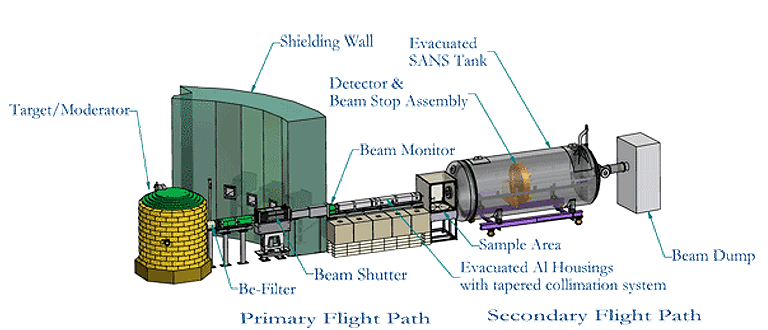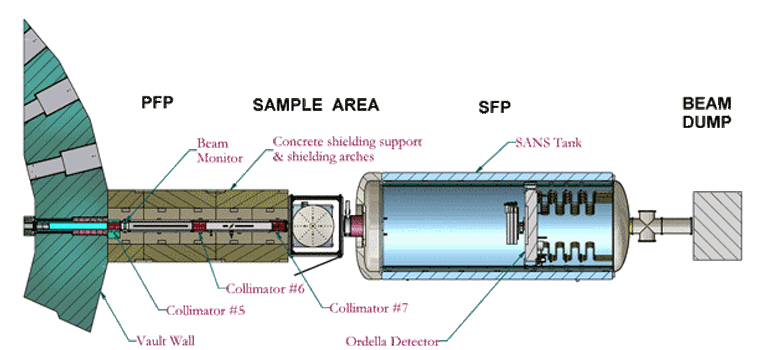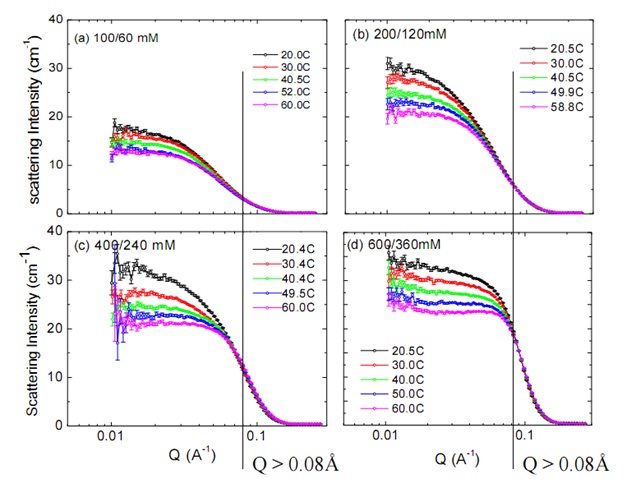Instrument Description
The NBL1-SANS instrument is the first of 4 neutron scattering instruments to be operational at LENS. It utilizes a pin-hole collimation and covers a Q-range of 0.008 – 0.5 Å-1 with a neutron flux of ~104 n/cm2/sec. This instrument allows one to probe scattering length density correlations over length scales from 20 -500Å. The instrument consists of 4 instrument sections (Primary Flight Path, Sample Area, Secondary Flight Path, and Beam Dump), where the vault wall constitutes the boundary between the TMR (Target Moderator Reflector) facility and the SANS Instrument. Figure 2 and 3 below show a layout and a picture of the SANS Instrument, respectively.
The Primary Flight Path (PFP) is the neutron transport system from the source (moderator) to the sample position. This is achieved by a series of evacuated Al-housings (square Al-tubes with Si-windows on each end) and a tapered collimation system (series of BN/Stainless Steel/BN sandwiches) placed inside. The source aperture views the entire moderator and has a diameter of 10 cm, whereas the sample aperture can be changed to various diameter sizes (1.5 cm, 2.0 cm, and 2.5 cm). A LN2 cooled Be-filter (4”x4”x4” Be block, beryllium assay 99.4%) is located inside of the TMR vault close to the caramel corn shielding with the purpose to minimize the flux of fast and epithermal neutrons. A beam monitor (low efficiency 3He detector) is located app. 20 cm from the vault wall at a break in the evacuated Al-housings. It is used for calibration and normalization of the scattering data.
The Sample Area (SA) consists of a 71 cm diameter sample rotation table, on which a variety of sample environment equipment can be mounted. Available equipment includes a closecycle refrigerator, sample changer with temperature control over a range from 10 to 60 C, and a pressure cell.
The Secondary Flight Path (SFP) incorporates the detection system for the scattered neutrons. It consists of an evacuated stainless steel tank (Si entrance window), the 2D detector (manufactured by ORDELA, model 2651N, serial# 002), and a beam stop assembly. The latter allows BN-beam stops of various sizes (3cm, 5cm, 8cm, and 10cm diameter, depending on sample-to-detector distance) to be driven into the incident beam in order to prevent damage of the area detector. The whole beam stop assembly can also be moved vertically for alignment purposes. The 2D-detector can be translated inside of the evacuated SANS tank, in order to change sample-to-detector distance, i.e. Q-range and Q-resolution. At the door in the back of the SANS tank, a 12” diameter ISO cross with a 20” long extension piece is attached and also evacuated. The Beam Dump (BD) functions as the beam stop for higher energy neutrons transmitted through the 2D detector and exiting the SFP.





